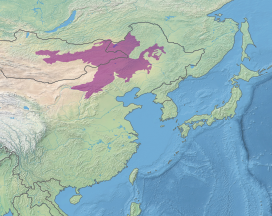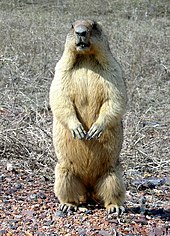Mongolian–Manchurian grassland
| Mongolian-Manchurian grassland | |
|---|---|
 | |
 Map of ecoregion in China and Mongolia | |
| Ecology | |
| Realm | Palearctic |
| Biome | Temperate grasslands, savannas, and shrublands |
| Geography | |
| Area | 887,000 km2 (342,000 sq mi) |
The Mongolian-Manchurian grassland ecoregion, also known as the Mongolian-Manchurian steppe, in the temperate grassland biome, is found in Mongolia, the Chinese Autonomous region of Inner Mongolia and northeastern China.
Setting
The Mongolian-Manchurian grassland covers an area of 887,300 square kilometers (342,600 sq mi). This temperate grasslands, savannas, and shrublands ecoregion of the Palearctic realm forms a large crescent around the Gobi Desert, extending across central and eastern Mongolia into the eastern portion of Inner Mongolia and eastern and central Manchuria, and then southwest across the North China Plain. To the northeast and north, the Selenge-Orkhon and Daurian forest steppes form a transition zone between the grassland and the forests of Siberia to the north. On the east and southeast, the grasslands transition to temperate broadleaf and mixed forests, including the Manchurian mixed forests, Northeast China Plain deciduous forests, and Central China loess plateau mixed forests. On the southwest, the grasslands extend to the Yellow River, across which is the Ordos Plateau steppe. It is between the Altai Mountains in the west and the Greater Khingan Region in the east.
Climate
The climate is temperate, with hot summers and cold winters. Being relatively dry, from a combination of lack of rainfall and being landlocked, only select animals can live here.
Environmental issues

In the winter the grass becomes dry and very flammable, making wildfires more common. Grass recovers quickly from the fire - however, trees do not. This partially explains the absence of trees in the area. There are also seasonal droughts in the grasslands, typically occurring during summer.
Culture
The majority of people in the steppe are nomads called Mongolians. Families in mongolian steppe live in "gers" which is a large portable tent. Mongolians are also master horse riders so many families own many horses that roam the steppe. The people in the steppe use the animals there for their food and drink. They also have a very prominent musical culture with a wide variety of traditional Mongolian songs.
Flora

The dominant flora consists of medium to tall grasslands, dominated by feather grass (Stipa baicalensis, S. capillata, and S. grandis), sheep's fescue (Festuca ovina), Aneurolepidium chinense, Filifolium sibiricuman, and Cleistogenes sqarrosa. The drier regions surrounding the Gobi host drought-tolerant grasses, together with forbs and low, spiny shrubs.
The southwestern slopes of the Greater Khingan range support pockets of broadleaf deciduous forest, of either Mongolian oak (Quercus mongolica), or a mixture of poplar (Populus davidiana and P. suaveolens), Siberian silver birch (Betula platyphylla), and willow (Salix rorida).
There are also plants such as;
- Feathergrass - It lives long since animals don’t consume it
- Sheepgrass - It is perennial.
- Lyme Grass - It can provide food for the animals who need it.
Fauna

- The brown eared-pheasant (Crossoptilon mantchuricum) is the sole endemic bird in the ecoregion.
- The bobak marmot (Marmota bobak), also known as the steppe marmot, inhabits the area
- The gray wolf lives here.
- The Mongolian gazelle is numerous here.
- The Przewalski's horse has been reintroduced here.
- The corsac fox
- Eagles
- Asian badger - They are commonly infected and they are bitten by parasites lice, fleas, and ticks. They have strong, long claws well-adapted for digging their homes and for food.
- Mongolian Gazelle - It provides a nice food supply for animals and will affect the plants they graze in. They can jump very high and far to escape predators they might encounter. Their small size allows them to adapt more easily to changes in their habitat.
- Steppe Lemming - They are a very important prey base. Their presence in an area can limit the presence of other voles. Unfortunately, they can also very easily reduce vegetation if necessary. They are very good at burrowing in the terrain. Have a very big migration when it may get too cold.
Conservation and threats
The Mongolian-Manchurian grassland faces threat from human expansion, though in most of its eastern area, it has not been altered by agriculture as much as its reaches in western Asia, or similar grasslands in North America.[1][2]
References
External links
- "Mongolian-Manchurian grassland". Terrestrial Ecoregions. World Wildlife Fund.
- Ecoregions of Asia
- Temperate grasslands, savannas, and shrublands
- Ecoregions of China
- Ecoregions of Russia
- Grasslands of China
- Grasslands of Mongolia
- Grasslands of Russia
- Environment of Mongolia
- Geography of Mongolia
- Biota of China
- Biota of Russia
- Biota of Mongolia
- Flora of Inner Mongolia
- Flora of Manchuria
- Flora of Northeast Asia
- Grasslands of Asia
- Palearctic ecoregions
- Ecoregions of Mongolia
